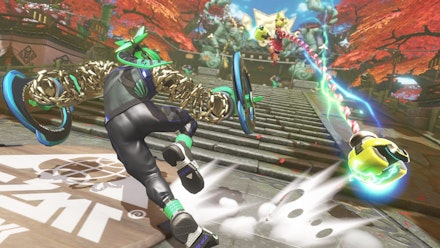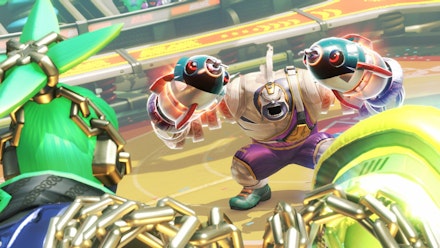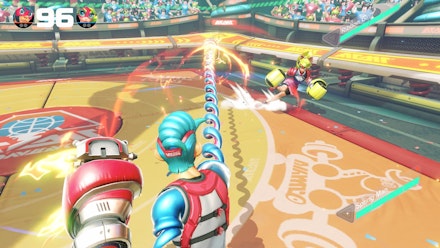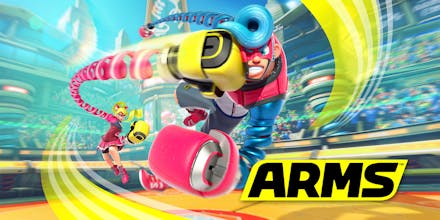Nintendo’s Switch may be an odd-looking beast, but from the moment the world saw its motion-sensing Joy-Con controllers and realised in many ways it resembles a more sophisticated version of the original Wii, it became obvious that it wouldn’t flop like the unfortunate Wii U. And while it’s still early days for the Switch, it now has an original game that makes great, party-friendly use of its best properties: ARMS.
On the face of it, ARMS is a motion-sensing boxing game. Visually, it could be a kids’ game, with bright, primary colours, bizarre-looking cartoon characters and in-your-face visual effects. But after you play it for a while, you begin to discern huge amounts of depth in it. And there’s no doubt that it will soon occupy a prominent position in the pantheon of e-sports – not only is it vastly more interesting to watch than the likes of League of Legends, pretty much any sentient being could understand what is going on it. That’s pretty good going, and bodes well for the Switch’s future.

Like any good Switch game, ARMS offers a vast number of different controller options – it’s possible to play it with the Joy-Cons attached to the base Switch, via a Classic Controller, or two people can take each other on in ARMS with one Joy-Con each (the game even supports four-player action). But the best way to play it is with a Joy-Con in each hand. You have to hold the Joy-Cons with the narrow side facing the TV screen, so that the triggers and bumpers face you.
Then you simply move around by tilting both Joy-Cons in whatever your favoured direction and punch by making punching movements (which can be pretty short – you won’t get far in ARMS by flailing wildly). But there’s plenty more to do: you can curve your punches left or right by twisting each hand. The right bumper lets you jump and the left bumper dash in whatever direction you’re moving. Punching with both hands simultaneously triggers a grab. And the more you jump, dash and land punches, the more your Flurry meter builds: when it’s full, a tap of either trigger lets you deal a super-fast flurry of punches which cumulatively cause a lot of damage.

If, that is, you’ve timed your flurry right and made sure you’re right in front of your opponent. And when you face an incoming flurry, you can block, by tilting the Joy-Cons towards each other. You soon learn that positioning and timing are key in ARMS: grabs, for example, are best launched when you’ve just evaded an attack from your opponent: if you don’t land them, they leave you hugely vulnerable to counter-attacks.
And that’s just the tip of the iceberg: ARMS may look like the simplest of games on the surface, but it has layers of depth waiting to be peeled away. The arenas, which are many and varied, influence your tactics. Some contain obstacles you can hide behind, which may or may not be destructible. Others have trampoline-like areas, springy boards or hovering platforms that you can use to get above your opponent, even if you have chosen a character which packs a heavy punch but isn’t overly manoeuvrable.
Simple in concept, easy to pick up yet really tough to master.
The ARMS themselves – you can pick from three on either side of your virtual body – have vastly differing characteristics. There are boxing gloves, mallets which are good for getting over the top of incoming attacks, variations on boomerangs which can be curved around satisfyingly, triple-rockets which move slowly so can be evaded but which pack a punch, and one character even has a parasol that is quite useful for blocking incoming attacks.
It’s vital to learn how your opponent moves and attack them in the right way at the right time. There are power-ups that occasionally drop into the arena, like bombs that you can punch towards your opponent, or electric shock-spheres that will temporarily immobilise any character that gets too close. ARMS contains some fun mini-games, such as V-Ball, which is volleyball with bombs, Hoops, which is all about nailing grabs in order to dunk your opponent through a basketball hoop and Skill Shot, in which targets pop up that you must punch before your opponent gets to them. There’s even a survival mode, called 1-on-100, which throws several opponents at you simultaneously, in a never-ending stream.
Structurally, ARMS is pretty minimal. The main Grand Prix mode – the closest thing the game has to a single-player campaign, although two people can also play through it – simply involves picking one of the ten characters and making your way through ten bouts against computer-controlled opponents, which also include some of the mini-games. You can set the difficulty level between one and seven, and that’s it. You do earn money which you can spend on new ARMS for your characters (after playing another mini-game), but it’s more a means of getting to know the characters intimately than anything which resembles a proper single-player campaign.

Online, there are two modes: one for general fun, and one entitled Ranked Match, which is only unlocked when you’ve completed Grand Prix at difficulty four and above. That is where you’ll head when you’ve developed the confidence to start shooting for a pro career in ARMS. Because ARMS is destined to be a player in the e-sports world: it’s great to watch and, unlike most e-sports, it’s easy to grasp what is going on at any given moment, but it has tactical and skill-based depth to rival the likes of Overwatch.
If you want to know what the Switch is all about, get your hands on ARMS. It’s an instant classic Nintendo franchise: simple in concept, easy to pick up yet really tough to master. It shows how the Switch has the same party-gaming spirit as the original Wii, yet loads more sophistication. Sure, it doesn’t have a properly coherent single-player campaign. But it’s utterly beguiling, whether you’re playing it or watching it.
